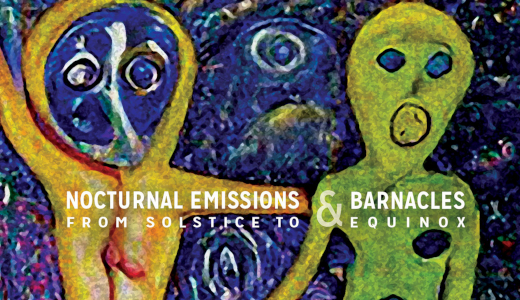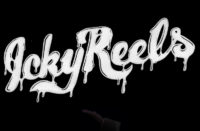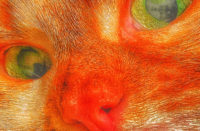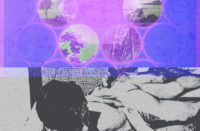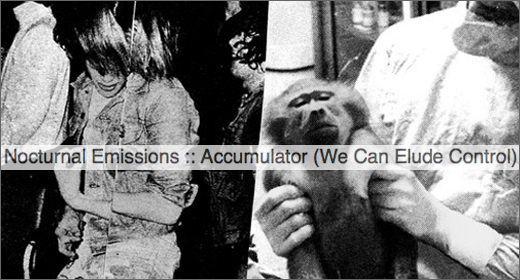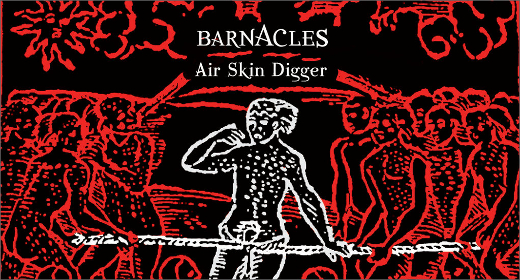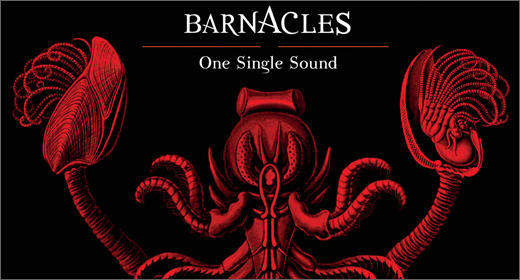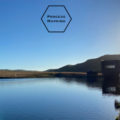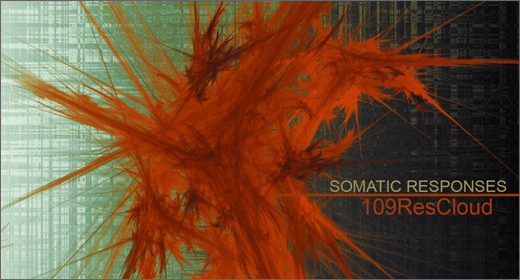Nocturnal Emissions and Barnacles have invited us to embark on an interstellar journey, urging us to question our place in the cosmos and embrace the boundless possibilities of the unknown. At times hauntingly beautiful, and at others discordant and dissonant, From Solstice to Equinox is a work that demands attention and rewards careful listening.
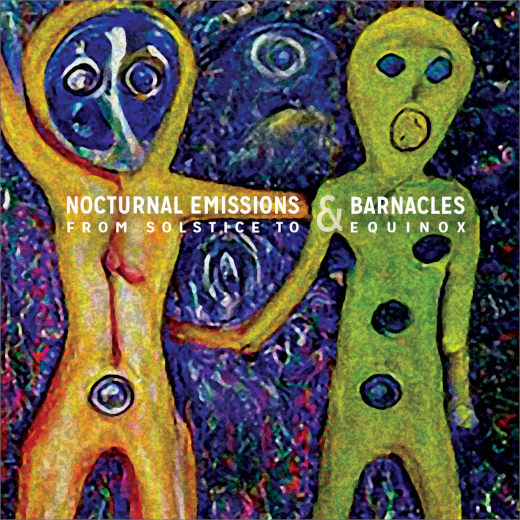
Breaking mind-forged manacles
It’s rare that I ever get a chance to visit Cornwall, having never gone overseas, but now it is possible through advances in machine learning, or what some folks call Artificial Intelligence. Since I’ve always wanted to go to Cornwall, I thought that might be a good destination for imaginary travel along the lines of magnetized fiber optic light. Traveling at the speed of communication I stopped off to visit Nigel Ayers, a British artist, musician, and member of the electronic resistance. Ayers makes his home in Lostwithiel and was kind enough to take some time out of his busy schedule of prolific creativity to sit down and have a ChatGPT with me about his new album with Italian musician Matteo Uggeri who works under the name Barnacles. Nigel Ayers virtual home exists in a realm outside the metaverse, in its own underground corner of the universal media netweb. Yet for a digital space outside the metaverse it remains very meta. Upon uploading my consciousness there I was struck by its warmth and character. Some digital homes feel like mere simulacra. This was not so. After refreshing my weary senses, and browser, he took me around to his home studio filled with vintage equipment, including a wall of synths and a reel-to-reel tape recorder, as well as stacks of cassette tapes and vinyl records lining the walls.
Nigel’s avatar was even more real than expected. He was a picture of casual creativity. I would say his hologrammatic form appeared to be made of light condensed down to near material form. He wore a faded t-shirt with a pulsating glitch design. (Nigel made glitch before glitch was a thing.) He has consistently leaked ideas into humanities mental sphere that other musicians and artists later pick up, recycle and recirculate. Yet even though this version of Nigel was an avatar, he was also human, and though virtual, not at all pretentious: he wore a pair of worn-down jeans, and a leather vest adorned with patches and pins, as if he’d just come back from a hardcore biker metal music festival.
Shaking chains and rattling the mental cages people have locked themselves inside ::
Ayers has long been known for his investigations into “hard rock” music, as exemplified on Stoneface and Spiritflesh where the stone circles, cairns, tors and the natural geology of Cornwall gave him etheric inspiration. Yet the patches and pins had a distinct otherworld look, as if they had been downloaded from some realm just beyond the border of dream. They were squiggly, as things are in dreams, and never stayed the same shape. His long, salt-and-pepper hair was tied back in a ponytail, and he sported a well-groomed goatee. I always get nervous when I meet someone whose work I’ve long admired, but his easy smile and a laid-back demeanor put me at ease. As we settled in to talk about his recent releases on the re-activated Sterile Records label, Ayers explained that he runs it as an experimental cottage-core industry. The spirit and ethos of the DIY movement are still strong in him. He handles everything from recording and production to distribution and promotion from his home studio. He then showed me his collection of vintage equipment, including a rare EMS Synthi AKS, and explained that he enjoys working with the limitations and quirks of analog gear, when not using apps on his cellphone to create quirky loops.
Nigel’s attention to detail and commitment to quality were evident in every aspect of his work, as should be expected from someone who has devoted their life to being a living example of the DIY ethos. He took great care in restoring and remastering the archive live recordings of Nocturnal Emissions, and he was passionate about providing a platform for innovative and experimental artists, whose ideas he wants to see take root in a revolutionary collective consciousness. As ever, he puts a lot of energy to breaking mind-forged manacles, shaking chains and rattling the mental cages people have locked themselves inside. Nigel has a had long term love affair with the cassette culture movement, and he spoke fondly of the days when cassette tapes were the primary medium for underground music. He was excited to see a renewed interest in the format in recent years, with sites like Bandcamp helping to make it easy for individual artists to distribute their own work, while reaching new audiences. Once my mind stopped reeling from the excitement of actually being in Nigel Ayers virtual home, we got to ChatGPTing about the new album with his friend from Milan.

Inter/eview ::
Justin :: How did you end up working on this collaborative album with Barnacles?
Nigel :: Matteo had spent a lot of time building up his Concrete Shelves blog where he exposed peoples record and book collections. People like Robin Rimbaud had their work showcased on his site. It was all rather exciting and unique. I contacted him about his humble blog and asked him if he would feature my own shelves. It was great because we ended up making this kind of concrète musique together after that, at least in terms of collage and cut-up, but it really owes a lot more to dub, a passion we both share.
Were there any kind of themes you were setting forward to explore while writing the lyrics, or did it just kind of bubble up organically as you worked on the new material?
Nigel :: Part of it came from my work as an experimental pataphysicist of consciousness. I used machines that speak to play material that was generated using cut-ups from scientific texts. I think this is what gives the lyrical element its particular elemental, yet metaversical flavor. By using “cut positions” and supplying my own sample library of “breaks” and keyboard hooks for Matteo to work with over the wires we were able to make a kind of hyperreal dub.
Tell me about the title, what is that all about?
Nigel :: It is a time of transformation, of shifting energies and changing tides. The world is in flux, caught between the bright blaze of summer and the cool embrace of autumn. And in this moment of transition, we are reminded of the power and beauty of nature, of its ability to both dazzle and humble us with its endless mysteries. From Solstice to Equinox, the world lies suspended in a delicate balance between light and dark, heat and chill. The sun blazes down upon the land, casting long shadows that stretch out like fingers, grasping at the last vestiges of summer. Yet even as the days grow shorter, the air remains thick with the scent of flowers and the hum of insects.
This time of transition and liminal spaces reminds me of the liminal aspects of your music. You’ve always explored those fringe areas between music and noise. You even call some of your pieces “decompositions.” In what ways was the music on this album “decomposed”?
Nigel :: Loops, bits, all kinds of material from the grab bag of sounds I’ve collected. In that I would put together these micro-packages of sound and send them over to Matteo. He also has a lot of other material on his hard drive that generous musicians have given him over the years to use. That is how we ended up having this virtual chamber group playing with us, everything from violins to saxophone, and that is all in the true spirit of dub. Then the back and forth happened. But in addition to the cut and the loop is the effect. Those got dubberated over it all, and serves as a kind of cosmic glue, like gravity, gelling it all together.
What are the ideal listening conditions for the album?
Nigel :: In a “series of sequences that don’t connect,” as it says in my lyrics. What you need to do is, when you get out of the office, smooth out your tie, go back home, dim the lights and put on the record. But because it is a “series of sequences that don’t connect” you don’t actually have to listen to the album in order. It is recommended, as a base point listen, but when it comes down to it, the album wasn’t written in order, or made in order, so it doesn’t need to be listened to in order. Time is a convenience for listening to music, but not necessary. It can be experienced at different points in life, or all at once, depending on end user preferences. “We need to anticipate all possibilities.”
That’s really interesting. I’ll have to give that a try in my next nocturnal dream listening session. What are you’re thoughts on using AI for making art?
Nigel :: I really love using AI — I think the trick is in how you edit it. If you can find a way of humanizing what comes out of it, so that it doesn’t look computerized, then it becomes a real aid to creation. Like cut ups, ready-mades and collage really, you are collaborating with; remixing existing culture. And something uncanny like a third mind emerges, I see it as a form of shamanism.
It was at this point that Matteo Uggeri materialized into the metaspace, and I was able to ask him a few questions about how the album came together.
Matteo, what was the genesis of this particular work?
Matteo :: Field recordings are an important element of all my work, and so I took the time to venture into forests, meadows, and mountains, recording the rustling leaves, chirping birds, and trickling streams. These recordings served as the foundation for the album, providing a bed of material to use throughout the album.
How has your work in education and multimedia influenced this work?
Matteo :: Collaboration is like a second language to me. I’ve spent a lot of time working in educational institutions and organizations to develop and implement multimedia projects. These initiatives often involve interdisciplinary collaborations, bringing together artists, musicians, educators, and students to explore the places where sound, visual arts, and technology all overlap. All of this helps foster creativity, critical thinking, and artistic expression in educational settings. Naturally, that influence is present in the creative work I do in my off hours. I’m committed to pushing artistic boundaries, nurturing talent, and fostering a deeper understanding and appreciation for experimental music and sound art. That’s why I enjoy working with people like Nigel and many others, such as Dominic Appleton in our Starlight Assembly side project. Working with other people on anything, helps to bring in a different slant of light than might otherwise be found.
What are your thoughts on collaborating with machine intelligence?
Matteo :: I think it goes in this direction of “humanization of AI” in a back and forth process of input/output/remix+rework+interpretation. Indeed AI is built on human culture and human products. Then, through prompts, we ask it for a “new” artefact, that has limits, it’s like unfinished, so we can build up upon it, as humans, other things, and make a new one.
Thank you both so much for your time. I’m going to wrap this inter/eview of your album up with some of my own reflections.
Nigel :: By all means. I’m glad you were able to come visit. Next time I’ll take you out to look for beasties on the Bodmin Moor.
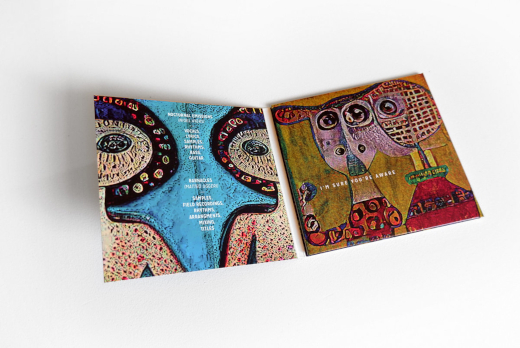
The subliminal underbelly of mutated technologies ::
This album is a perfect reflection of one of Nocturnal Emissions core concerns, the effect of technology, media, and communication on culture and society. Yet the Emissions emitted by Ayers in his Nocturnal project have also been just as concerned with our interactions to landscape and space. So it is no surprise to see him and Barnacles address issues such as the movement of time from one moment of time often seen as sacred, the solstice, to another sacred time.
Overall, the album is a captivating exploration of sound and emotion, a work that transcends the dub and experimental genres, and bypasses the industrial genre Nocturnal Emissions so often gets lumped into, to create a fragile space where the listener is exposed to the subliminal underbelly of mutated technologies as they leak out from the laboratories to transform our world. The songs are like a “small group of spidery symbols that glitter in the night” as Nigel speak-sings at one point.
This is an interesting idea. The esoteric mystic and philosopher Rudolf Steiner once had a vision that he spoke of in 1921 that seemed to be a precursor to what we now know as the internet. “And from the earth will well up terrible creations of beings who in their character stand between the mineral kingdom and the plant kingdom as automative beings with a supernatural intellect, an immense intellect. When this development takes hold, the earth will be covered, as with a web, a web of terrible spiders, spiders of enormous wisdom, which however, in their organisation don’t even reach the plant status. Terrible spiders which will interlock with each other, which will imitate in their movements all that which humanity has thought of with their shadowlike intellect.” *
Another strength of the album is in its ability to provoke this sense of a knotted web covering our world with silken fiber optic strands. The way songs such as “Crashing My Fan” take the wind out of the sails of stalker type music fanatics, is in its way, revolutionary. “I Wish I Was Joyful” puts a tearjerker spin on to the usual upbeat dub genre and darkens, just as the days got shorter on the path from summer solstice to vernal equinox. Vitamin D got depleted, and the kind of malaise so common in our warbled world set in. It makes you feel like you are not alone. On the closing strains of “Night Cough Onions” the collaborators take us on twisted disco pub crawl through a musical underworld populated by disparate sonic textures and malleated memories.
The album unfolds like a labyrinthine narrative ::
From Solstice to Equinox is a magnum opus that can be likened to a swirling vortex of sonic experimentation and mythological allegory. Like modern-day alchemists, Ayers and Uggeri, masterfully blend elements of dub, dada and slipstream chamber works to create a transcendent auditory experience that challenges conventional musical boundaries. The album unfolds like a labyrinthine narrative, with each track offering a fragment of each artists unique vision. The work can be listened to as another sonic testament to Ayer’s longstanding fascination with stone circles and seasonal cycles themes and his propensity for infusing his music with cosmic symbolism. It also showcases his strength as a collaborator.
“Sick Summer End Sucks” sets the strange for the out-of-body experience longtime emitters have come to expect. Ayer’s otherworldly voice floats atop a bed of dubby basslines and cascading echoes, as if channeling messages from a distant galaxy. “Dubbed Postal Office” delves deeper into the abyss of mail art and terrestrial communication systems, with its hypnotic rhythms and cascading layers of dub effects giving it a stamp that is both mesmerizing and disorienting. Uggeri’s visionary production techniques are on full display throughout the album. He fearlessly manipulates sound, warping and distorting it to create a dark hallucinatory world both familiar and alien. Tracks like “RSA Search,” and “Trem Me Tribal” serve as sonic portals, transporting the listener to uncharted realms where time and space lose their conventional
meaning.
Beyond its unsettling vibrations the songs are rife with metaphorical depth and social commentary. Ayer lyrics, delivered with his idiosyncratic vocal style, are enigmatic and steeped in symbolism. “I Wish I Was Joyful” explores themes of human alienation and the search for meaning in an indifferent universe. In “Positive Equinox Navigator,” Ayers’s delivers a poignant critique of societal norms and calls for liberation from oppressive systems. Uggeri’s ability to seamlessly weave disparate musical elements together is a testament to his prodigious talent as a producer and his idiosyncratic approach to music-making. He transcends genre boundaries, creating a melting mélange that is both innovative and accessible. As a whole, the album is a testament to Uggeri’s ability to seek out the dusty corners of creativity where forging a new musical path that resonates with both dub purists and “out sound” listeners alike.
Nocturnal Emissions and Barnacles have invited us to embark on an interstellar journey, urging us to question our place in the cosmos and embrace the boundless possibilities of the unknown. At times hauntingly beautiful, and at others discordant and dissonant, From Solstice to Equinox is a work that demands attention and rewards careful listening. Uggeri’s willingness to experiment with form and structure is evident throughout the album, and his use of unconventional instrumentation and techniques gives the work a sense of urgency and immediacy. In the end this album is as Wiley as a coyote. A trickster waiting to unleash change the unwary and uninitiated through its complex rhythms, speculative structure, and painstakingly assembled musical textures. With this album, Nocturnal Emissions and Barnacles put forth an utterly unique imprint on the imagination of those who dare to listen.
*See John Michael Greer’s essay The Subnatural Realm: A Speculation.
From Solstice to Equinox is available on Klanggalerie. [Bandcamp | Site]






